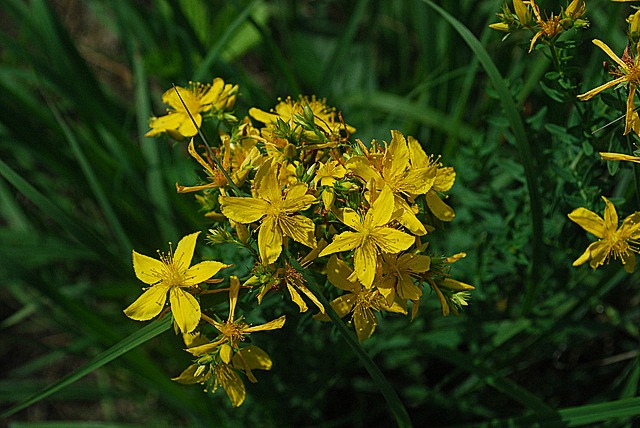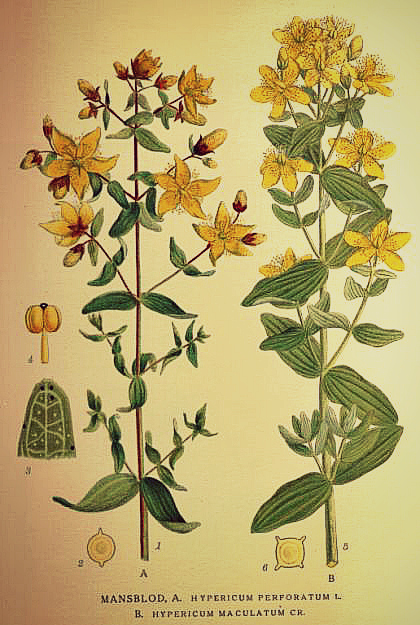Herb of the Month: Saint Joan’s/John’s Wort (Hypericum perforatum)

June 24th is known in the Christian Tradition as Saint John the Baptist’s Day. The plant, Hypericum perforatum, was named after St John because it was used to “chase demons away”. This beautiful plant grows in a variety of soils and conditions. I have often found it near roadsides or in meadows. It grows to about 2 feet high, with small ovate (oval) leaves, that when picked and held to the sun, have visible pores. Some of these pores may even be filled with oil, appearing as blackish dots, and this is an excellent indication that you have found this marvelous friend. These same spots are also present on the flowers, and when bruised, the flowers will release a blood-red oil. The flowers are small, about the size of a jelly-bean. They have 5 petals, and are bright yellow.
St. Joan’s Wort is traditionally harvested near the 24th of June, because at this time, depending on the zone you live in, there are buds, open flowers and expired flowers present on the plant. This means that the plant’s energy is flowing through the plant and makes much better medicine. The seeds have a higher concentration of oil, as do the flowers themselves, but as with most plant-based medicines, the medicinal properties come from combined constituents of the plant, not just individual chemicals. When using St. J’s for medicine, it is ideal to harvest the upper portion of the plant, including flowers, leaves and stems.
I believe that St. John’s / Joan’s Wort was said to ‘cast out demons’ because of its effect on insomnia, depression, and general anxiety. These symptoms were viewed long ago to be inflicted on humans by dark forces, and so, the plant blessed by the Saint, would out the demons. Sometimes “old wives tales” can be spot on. Scientific studies have not come to a conclusive decision on which constituents of St. J’s are affecting the brain, but it is believed to prevent serotonin re-uptake, similar to other anti-depression medications dubbed SSRIs (Selective Serotonin Re-uptake Inhibitors).
“Two constituents that play a significant role are hypericin and hyperforin. Although hypericin was formerly thought to be the component of St. John’s wort principally responsible for its action, it is now understood that hyperforin, adhyperforin, and several other related compounds are the primary active constituents. These appear to modulate the effects of serotonin, dopamine, and norepinephrine” –quoted text
The chemicals listed above are all chemicals in the brain that are said to regulate moods and sleep patterns. So, with St. J’s interacting with the cells that produce and/or respond to these chemicals, it makes sense that this herb can be relied upon for mood stabilizing and sleep issues like insomnia.
St Joan’s Wort is also used topically, as an infused oil. Sometimes it is added to salves and balms. St. J’s acts on a nervous level, and is very good at easing strain and pain in deep tissue. I knew someone with herniated discs in their back, who was massaged daily with St. Joan’s Wort infused oil, and he said it helped reduce the pain significantly. I have had massages myself with the oil, and it works wonders on sore, tired, stressed muscles. (I just found a lovely website discussing lots and lots of things, and want to share it! HERE I am linking a post about St John’s Wort in particular, but they have ALOT of content on herbs and alternative medicines in general.)
I have found that St. John’s Wort, in my own personal experience, when used topically it: helps to speed the healing of burns, cuts and scrapes, helps heal bruises, strained or strained muscles, and relieves pain in deep tissue with great effectiveness. When taken to boost moods, I felt it as a lightening of my mood, when I experienced SAD (Seasonal Affective Disorder) symptoms, and I feel it helps support emotional healing from negative thought patterns that sometimes run in the back of my mind. I will point people in the direction of this page, just to let you all know that all content on my website is coming from my own personal perspective and has not been analyzed, certified, or supported by any medical professional or regulatory body.
To harness the wondrous gifts of this humble plant, there are many approaches we can take. Tisanes are very simple, and a gentle way to introduce a plant’s healing properties to the body.
Making a Tisane with St. Joan’s Wort:
Take 1-3 teaspoons of dried St. Joan’s Wort and pour boiling water over it. Allow it to steep for at least 15 minutes. Sweeten to taste. For insomnia, anxiety, SAD symptoms or just a boost of sunny, happy feelings, drink a cup 3 times daily.
To Tincture St. John’s Wort:
Harvesting the flowering tops of the plant in late June, be sure to leave some stalks untouched on each plant or in each clump that you are harvesting from. It is important to allow wild medicinal plants to go to seed, so that in the future, there will be medicine for others who need it. Chop the freshly harvested flowers, stems and leaves into small pieces. Fill up a mason jar, and cover all plant material with 100 proof vodka (preferable, but any vodka or strong alcohol will do the trick). Cap tightly, label with the date, and leave it to sit somewhere sunny for 6 weeks. When 6 weeks have passed, strain out the plant matter, and compost it. Bottle your tincture (I use dropper bottles) and use as follows:
Adult dosage: 15-35 drops, 3 times daily when symptoms are present. Adding it to an ounce of juice can help hide the strong alcohol taste.
Here is a video of Susun Weed preparing a tincture, demonstrating how quick and simple this process can be.
Making an infused oil:
It is a very simple thing to do. Harvest fresh plant material, when the plant is flowering. As I mentioned before, try to harvest when you see buds, open flowers and spent flowers going to seed. Take the top portion of the plant, and cut into small pieces, about 1 or 2 inches long. Fill a clean, dry jar with the plant matter, and cover with oil. Good oils to use: olive oil, sweet almond oil, grape seed oil, sunflower oil.When covering with oil, have a chopstick or popsicle stick handy, to remove any air bubbles.
Make sure that the plant matter is dry. This is really important. No dew or rainwater should be on the plant material. If you have the time, allowing the plant to wilt for a few hours can be beneficial too. The worst thing when making an infused oil, is having too much moisture. Moisture will make the oil go rancid. So, wilting the herb is definitely a good idea if you have the time. Seal your jar tightly, and label with the date you infused. After 6 weeks in the sunshine, your St. John’s Wort oil will be a beautiful ruby red colour. This is how you know it is ready.
Strain out the herbs through a cheesecloth, squeezing out as much oil as you can. Again, make sure your hands, jars and cloths are DRY!
If your oil turned only a little pink, that is okay too. Sometimes it depends on the area, the time harvested, the strength of the plant….so don’t be worried. If you want a really strong oil, you can do a double infusion. So, after 6 weeks, strain the herbs out of the oil through a cheesecloth, squeezing out as much oil from the herbs as you can. Then, get some more St. John’s Wort, and do the same process a second time.
Under ideal conditions, this infused oil should last you at least 1 year, if kept in a cool dark place. I use coloured glass bottles and jars to store oils in.
I hope you enjoy using this lovely plant. Blessings!
